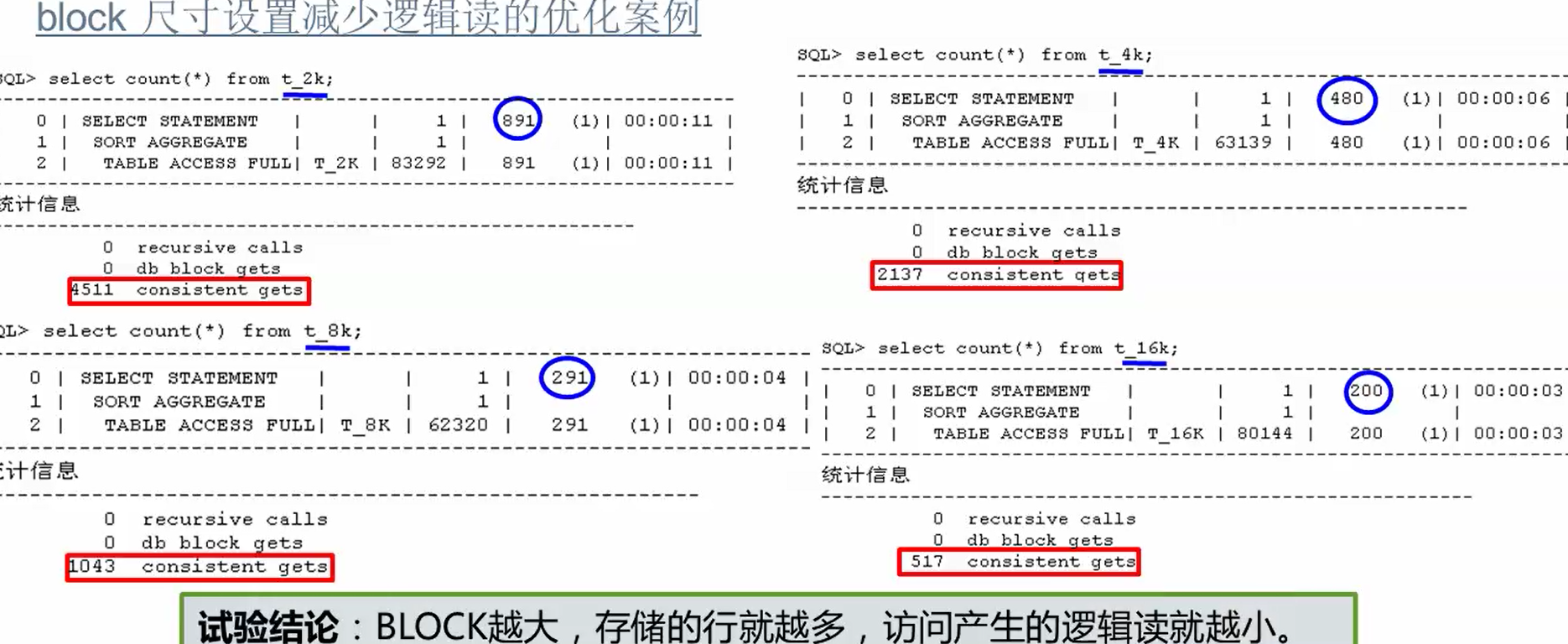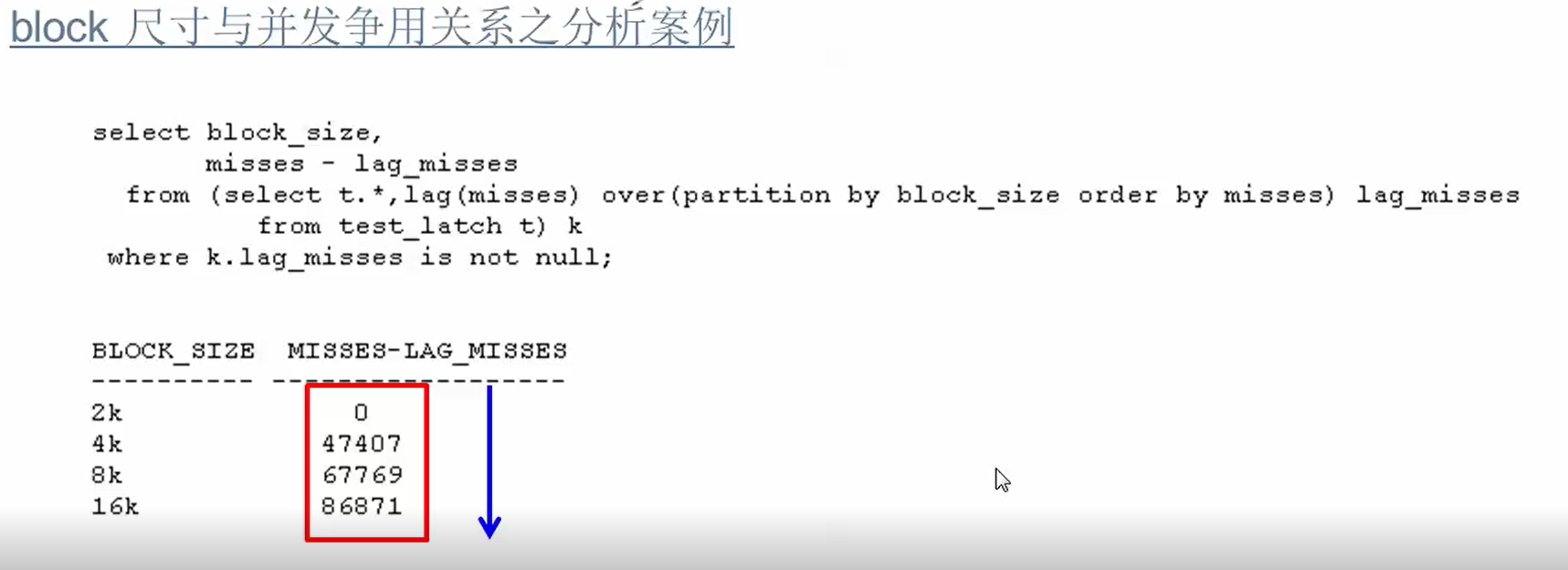Oralce行定位与rowid:

drop table t purge;
create table t as select * from dba_objects;
create index idx_object_id on t(object_id);
set linesize 1000
set autotrace traceonly
--方法1(全表扫描)
select /*+full(t)*/ * from t where object_id=2;
--方法2(索引扫描)
select * from t where object_id=2;
--方法3(rowid扫描)
set autotrace off
select rowid from t where object_id=2;
set autotrace traceonly
select * from t where object_id=2 and rowid='AAAYiZAALAAAADLAAw';
SQL> select /*+full(t)*/ * from t where object_id=2;
--------------------------------------------------------------------------
| Id | Operation | Name | Rows | Bytes | Cost (%CPU)| Time |
--------------------------------------------------------------------------
| 0 | SELECT STATEMENT | | 1 | 207 | 291 (1)| 00:00:04 |
|* 1 | TABLE ACCESS FULL| T | 1 | 207 | 291 (1)| 00:00:04 |
--------------------------------------------------------------------------
统计信息
----------------------------------------------------------
0 recursive calls
0 db block gets
1044 consistent gets
SQL> select * from t where object_id=2;
---------------------------------------------------------------------------------------------
| 0 | SELECT STATEMENT | | 1 | 207 | 2 (0)| 00:00:01 |
| 1 | TABLE ACCESS BY INDEX ROWID| T | 1 | 207 | 2 (0)| 00:00:01 |
|* 2 | INDEX RANGE SCAN | IDX_OBJECT_ID | 1 | | 1 (0)| 00:00:01 |
---------------------------------------------------------------------------------------------
统计信息
----------------------------------------------------------
0 recursive calls
0 db block gets
4 consistent gets
SQL> select * from t where object_id=2 and rowid='AAAYiZAALAAAADLAAw';
-----------------------------------------------------------------------------------
| 0 | SELECT STATEMENT | | 1 | 219 | 1 (0)| 00:00:01 |
|* 1 | TABLE ACCESS BY USER ROWID| T | 1 | 219 | 1 (0)| 00:00:01 |
-----------------------------------------------------------------------------------
统计信息
----------------------------------------------------------
0 recursive calls
0 db block gets
1 consistent gets

---启动大小为2K的块新建表空间(WINDOWS下只能使用2K,4K,8K和16K
alter system set db_2k_cache_size=100M;
drop tablespace tbs_ljb_2k including contents and datafiles;
create tablespace TBS_LJB_2k
blocksize 2K
datafile 'D:\ORACLE\ORADATA\TEST11G\TBS_LJB_2K_01.DBF' size 100M
autoextend on
extent management local
segment space management auto;
create table t_2k tablespace tbs_ljb_2k as select * from dba_objects;
---启动大小为4K的块新建表空间
alter system set db_4k_cache_size=100M;
drop tablespace tbs_ljb_4k including contents and datafiles;
create tablespace TBS_LJB_4k
blocksize 4K
datafile 'D:\ORACLE\ORADATA\TEST11G\TBS_LJB_4K_01.DBF' size 100M
autoextend on
extent management local
segment space management auto;
create table t_4k tablespace tbs_ljb_4k as select * from dba_objects;
---启动大小为8K的块新建表空间(默认就是8K)
drop table t_8k purge;
create table t_8k as select * from dba_objects;
---启动大小为16K的块新建表空间
alter system set db_16k_cache_size=100M;
drop tablespace tbs_ljb_16k including contents and datafiles;
create tablespace TBS_LJB_16k
blocksize 16K
datafile 'D:\ORACLE\ORADATA\TEST11G\TBS_LJB_16K_01.DBF' size 100M
autoextend on
extent management local
segment space management auto;
create table t_16k tablespace tbs_ljb_16k as select * from dba_objects;
-----------------------------------------------------------------------------------------
--开始试验,发现代价和逻辑读都是以此变少!
SET autotrace traceonly
select count(*) from t_2k;
/
select count(*) from t_4k;
/
select count(*) from t_8k;
/
select count(*) from t_16k;
/
--但是也不是块越大越好,要注意热点块竞争。
SQL> select count(*) from t_2k;
-------------------------------------------------------------------
| 0 | SELECT STATEMENT | | 1 | 891 (1)| 00:00:11 |
| 1 | SORT AGGREGATE | | 1 | | |
| 2 | TABLE ACCESS FULL| T_2K | 83292 | 891 (1)| 00:00:11 |
-------------------------------------------------------------------
统计信息
----------------------------------------------------------
0 recursive calls
0 db block gets
4511 consistent gets
SQL> select count(*) from t_4k;
-------------------------------------------------------------------
| 0 | SELECT STATEMENT | | 1 | 480 (1)| 00:00:06 |
| 1 | SORT AGGREGATE | | 1 | | |
| 2 | TABLE ACCESS FULL| T_4K | 63139 | 480 (1)| 00:00:06 |
-------------------------------------------------------------------
统计信息
----------------------------------------------------------
0 recursive calls
0 db block gets
2137 consistent gets
SQL> select count(*) from t_8k;
-------------------------------------------------------------------
| 0 | SELECT STATEMENT | | 1 | 291 (1)| 00:00:04 |
| 1 | SORT AGGREGATE | | 1 | | |
| 2 | TABLE ACCESS FULL| T_8K | 62320 | 291 (1)| 00:00:04 |
-------------------------------------------------------------------
统计信息
----------------------------------------------------------
0 recursive calls
0 db block gets
1043 consistent gets
SQL> select count(*) from t_16k;
--------------------------------------------------------------------
| 0 | SELECT STATEMENT | | 1 | 200 (1)| 00:00:03 |
| 1 | SORT AGGREGATE | | 1 | | |
| 2 | TABLE ACCESS FULL| T_16K | 80144 | 200 (1)| 00:00:03 |
--------------------------------------------------------------------
统计信息
----------------------------------------------------------
0 recursive calls
0 db block gets
517 consistent gets

--查看系统Oracle块的大小
sqlplus "/ as sysdba"
show parameter db_block_size
select block_size
from dba_tablespaces
where tablespace_name='SYSTEM';
---启动大小为2K的块新建表空间(WINDOWS下只能使用2K,4K,8K和16K)
alter system set db_2k_cache_size=100M;
drop tablespace tbs_ljb_2k including contents and datafiles;
create tablespace TBS_LJB_2k
blocksize 2K
datafile 'D:\ORACLE\ORADATA\TEST11G\TBS_LJB_2K_01.DBF' size 100M
autoextend on
extent management local
segment space management auto;
create table t_2k tablespace tbs_ljb_2k as select * from dba_objects where rownum<=100;
---启动大小为4K的块新建表空间
alter system set db_4k_cache_size=100M;
drop tablespace tbs_ljb_4k including contents and datafiles;
create tablespace TBS_LJB_4k
blocksize 4K
datafile 'D:\ORACLE\ORADATA\TEST11G\TBS_LJB_4K_01.DBF' size 100M
autoextend on
extent management local
segment space management auto;
create table t_4k tablespace tbs_ljb_4k as select * from dba_objects where rownum<=100;
---启动大小为8K的块新建表空间(默认就是8K)
drop table t_8k purge;
create table t_8k as select * from dba_objects where rownum<=100;
---启动大小为16K的块新建表空间
alter system set db_16k_cache_size=100M;
drop tablespace tbs_ljb_16k including contents and datafiles;
create tablespace TBS_LJB_16k
blocksize 16K
datafile 'D:\ORACLE\ORADATA\TEST11G\TBS_LJB_16K_01.DBF' size 100M
autoextend on
extent management local
segment space management auto;
create table t_16k tablespace tbs_ljb_16k as select * from dba_objects where rownum<=100;
--之前试验过块越大,逻辑读越少,但是实际情况并非块越大越好,还要注意热点块竞争。
-------------------------------------------------------------------------------------------------------------------------------------------
sqlplus "/ as sysdba"
grant all on DBMS_LOCK to ljb;
connect ljb/ljb
--创建一个包来构造各种JOB,分析问题
create or replace package pkg_test_block_size
as
procedure p_t_2k;
procedure p_t_4k;
procedure p_t_8k;
procedure p_t_16k;
procedure p_exec_2k_job;
procedure p_exec_4k_job;
procedure p_exec_8k_job;
procedure p_exec_16k_job;
procedure p_remove_job;
end pkg_test_block_size;
/
create or replace package body pkg_test_block_size
as
procedure p_t_2k as
begin
for j in 1..1000 loop
for i in (select * from t_2k ) loop
null;
end loop;
end loop;
end p_t_2k;
procedure p_t_4k as
begin
for j in 1..1000 loop
for i in (select * from t_4k ) loop
null;
end loop;
end loop;
end p_t_4k;
procedure p_t_8k as
begin
for j in 1..1000 loop
for i in (select * from t_8k ) loop
null;
end loop;
end loop;
end p_t_8k;
procedure p_t_16k as
begin
for j in 1..1000 loop
for i in (select * from t_16k ) loop
null;
end loop;
end loop;
end p_t_16k;
--创建JOB
procedure p_exec_2k_job as
JOBNO NUMBER;
BEGIN
for i in 1..100 loop
DBMS_JOB.SUBMIT( JOBNO,
'pkg_test_block_size.p_t_2k;',
SYSDATE,
'SYSDATE+1/1440');
end loop;
DBMS_LOCK.sleep(120);
END p_exec_2k_job;
procedure p_exec_4k_job as
JOBNO NUMBER;
BEGIN
for i in 1..100 loop
DBMS_JOB.SUBMIT( JOBNO,
'pkg_test_block_size.p_t_4k;',
SYSDATE,
'SYSDATE+1/1440');
end loop;
DBMS_LOCK.sleep(120);
END p_exec_4k_job;
procedure p_exec_8k_job as
JOBNO NUMBER;
BEGIN
for i in 1..100 loop
DBMS_JOB.SUBMIT( JOBNO,
'pkg_test_block_size.p_t_8k;',
SYSDATE,
'SYSDATE+1/1440');
end loop;
DBMS_LOCK.sleep(120);
END p_exec_8k_job;
procedure p_exec_16k_job as
JOBNO NUMBER;
BEGIN
for i in 1..100 loop
DBMS_JOB.SUBMIT( JOBNO,
'pkg_test_block_size.p_t_16k;',
SYSDATE,
'SYSDATE+1/1440');
end loop;
DBMS_LOCK.sleep(120);
END p_exec_16k_job;
procedure p_remove_job as
BEGIN
for i in (select job from user_jobs )loop
DBMS_JOB.remove(i.job);
end loop;
END p_remove_job;
END pkg_test_block_size;
drop table test_latch purge;
create table test_latch (block_size varchar2(10),id number,gets number , misses number, sleeps number, immediate_gets number);
--测试1.
delete from test_latch where block_size='2k';
insert into test_latch select '2k',1,gets,misses,sleeps,immediate_gets from v$latch where name='cache buffers chains';
commit;
--exec dbms_workload_repository.create_snapshot();
exec pkg_test_block_size.p_exec_2k_job;
--exec dbms_workload_repository.create_snapshot();
insert into test_latch select '2k',2,gets,misses,sleeps,immediate_gets from v$latch where name='cache buffers chains';
commit;
--测试结束
exec pkg_test_block_size.p_remove_job;
--@?/rdbms/admin/awrrpt.sql
--测试2.
delete from test_latch where block_size='4k';
insert into test_latch select '4k',1,gets,misses,sleeps,immediate_gets from v$latch where name='cache buffers chains';
commit;
--exec dbms_workload_repository.create_snapshot();
exec pkg_test_block_size.p_exec_4k_job;
--exec dbms_workload_repository.create_snapshot();
insert into test_latch select '4k',2,gets,misses,sleeps,immediate_gets from v$latch where name='cache buffers chains';
commit;
--测试结束
exec pkg_test_block_size.p_remove_job;
--@?/rdbms/admin/awrrpt.sql
--测试3.
delete from test_latch where block_size='8k';
insert into test_latch select '8k',1,gets,misses,sleeps,immediate_gets from v$latch where name='cache buffers chains';
commit;
--exec dbms_workload_repository.create_snapshot();
exec pkg_test_block_size.p_exec_8k_job;
--exec dbms_workload_repository.create_snapshot();
insert into test_latch select '8k',2,gets,misses,sleeps,immediate_gets from v$latch where name='cache buffers chains';
commit;
--测试结束
exec pkg_test_block_size.p_remove_job;
--@?/rdbms/admin/awrrpt.sql
--测试4.
delete from test_latch where block_size='16k';
insert into test_latch select '16k',1,gets,misses,sleeps,immediate_gets from v$latch where name='cache buffers chains';
commit;
--exec dbms_workload_repository.create_snapshot();
exec pkg_test_block_size.p_exec_16k_job;
--exec dbms_workload_repository.create_snapshot();
insert into test_latch select '16k',2,gets,misses,sleeps,immediate_gets from v$latch where name='cache buffers chains';
commit;
--测试结束
exec pkg_test_block_size.p_remove_job;
--@?/rdbms/admin/awrrpt.sql
SELECT WHAT, INTERVAL, JOB, NEXT_DATE, NEXT_SEC, FAILURES, BROKEN FROM USER_JOBS WHERE INTERVAL = 'SYSDATE+1/1440';
select * from v$latch_children where name='cache buffers chains'
select * from test_latch;
--以下结果仅供参考,实际执行情况可能由于数据量不够大,并发不够大,而有差异。
select block_size,
misses - lag_misses
from (select t.*,lag(misses) over(partition by block_size order by misses) lag_misses
from test_latch t) k
where k.lag_misses is not null;
BLOCK_SIZE MISSES-LAG_MISSES
---------- ------------------
2k 0
4k 47407
8k 67769
16k 86871
观察:
select t.*, s.sid, s.serial#, s.machine, s.program, s.osuser
from (select c.USERNAME,
a.event,
a.cnt as "TIME(SECOND)",
a.sql_id,
b.sql_fulltext
from (select rownum rn, t.*
from (select decode(s.session_state,
'WAITING',
s.event,
'Cpu + Wait For Cpu') Event,
s.sql_id,
s.user_id,
count(*) CNT
from v$active_session_history s
where sample_time > sysdate - 15 / 1440
group by s.user_id,
decode(s.session_state,
'WAITING',
s.event,
'Cpu + Wait For Cpu'),
s.sql_id
order by CNT desc) t
where rownum < 20) a,
v$sqlarea b,
dba_users c
where a.sql_id = b.sql_id
and a.user_id = c.user_id
order by CNT desc) t,
v$session s
where t.sql_id = s.sql_id(+);